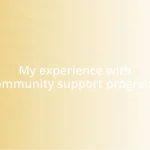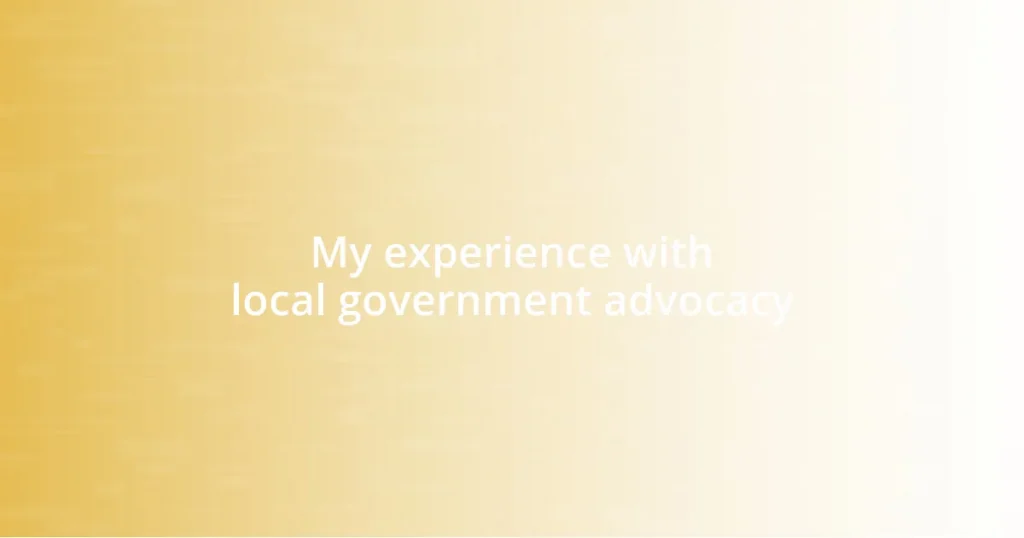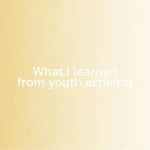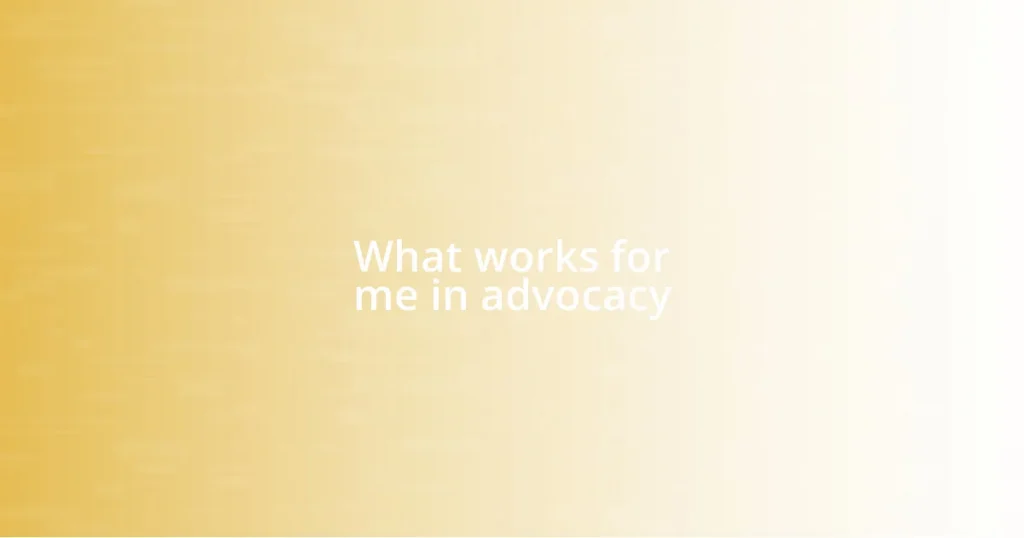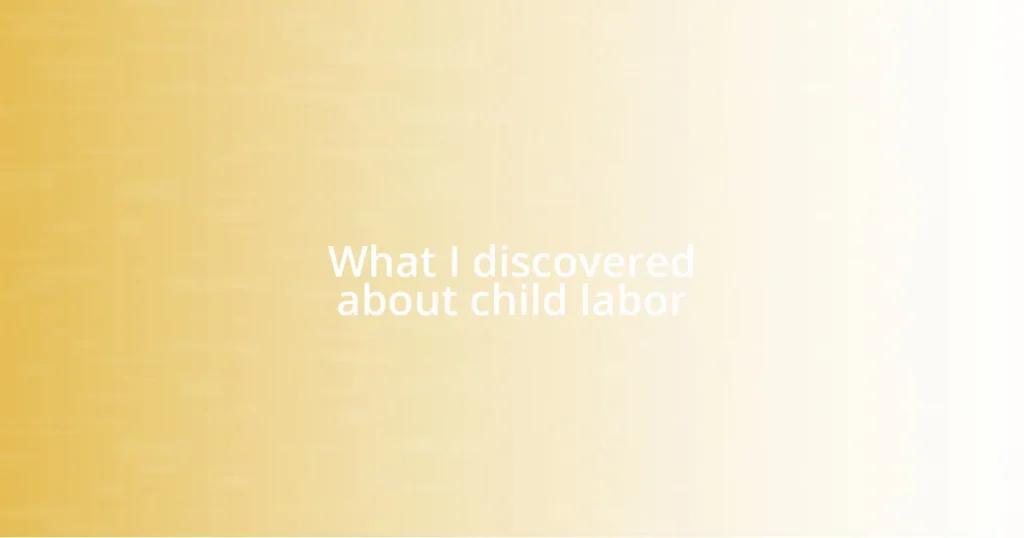Key takeaways:
- Effective local advocacy combines understanding processes, building relationships, and community engagement to drive meaningful change.
- Personalized messaging and storytelling enhance influence, making ideas resonate with decision-makers.
- Collaboration with local organizations amplifies efforts, emphasizing the strength of a united community in advocating for common goals.
- Evaluating advocacy outcomes through community feedback is crucial for ensuring that initiatives meet local needs and sustain ongoing engagement.

Understanding local government advocacy
Local government advocacy is all about making your voice heard within your community. I remember attending my first town hall meeting, feeling a mix of excitement and nervousness. It struck me that my concerns about park safety were important; it wasn’t just my voice but a collective effort to drive change. Isn’t it empowering to realize that we can influence policies that directly affect our lives?
Being effective in this realm requires understanding both the processes and the people involved. I once joined a local advocacy group and learned how building relationships with council members can be more impactful than any petition. It’s like a dance; when you find the right rhythm with local officials, it opens doors for genuine dialogue. Have you ever thought about how much easier it is to advocate when you know the individuals involved in decision-making?
Advocacy isn’t just about policy; it’s about passion and persistence. I recall a time when our community fought for better public transportation. It was overwhelming at first, seeing the challenges ahead. Yet, we fueled each other’s determination, which eventually led to a successful outcome. This experience taught me that when people unite for a common cause, their shared enthusiasm can truly spark change. Wouldn’t it be great if more people realized the impact of local advocacy?

Importance of community engagement
Community engagement is crucial in local advocacy, as it not only amplifies voices but also fosters a sense of belonging. During a community clean-up project, I noticed how everyone came together, sharing not just tasks but stories. It hit me that when people feel involved in their neighborhood, they are more likely to care and take action. This connection adds emotional weight to any advocacy efforts.
- Engaged communities can identify local needs and prioritize issues.
- Active participation creates opportunities for dialogue with decision-makers.
- Collective action fosters stronger relationships among residents.
It’s fascinating how even small moments of engagement can yield significant impact. Reflecting on a recent neighborhood forum, I was moved by the heartfelt discussions about education failures. People really opened up, which sparked a deep understanding among us. It’s these shared experiences that not only inform advocacy but also bind the community closer.

Strategies for effective advocacy
When it comes to advocating effectively, knowing your audience is essential. Understanding who makes the decisions can make or break your efforts. For instance, I’ve spent hours researching local representatives, learning about their priorities and values. This effort paid off significantly when I tailored my message about sustainable development in our town, catching the attention of someone who was genuinely passionate about environmental issues. Isn’t it interesting how a little personalization can strengthen your case?
Building coalitions can also amplify your advocacy. Creating partnerships with like-minded organizations can extend your reach and influence. I remember collaborating with a local environmental group to co-host an event highlighting green initiatives. The combined energy and resources of both groups turned a simple event into an impactful community gathering, drawing hundreds of attendees. Collaboration not only brings diverse voices together but also learns from each other’s strengths.
Finally, leveraging storytelling is a powerful strategy in advocacy. Sharing personal stories evokes empathy and fosters connection. During a public hearing on housing policy, I decided to share my own experience of struggling to find affordable housing. It wasn’t easy to open up, but the emotional response from the audience was palpable. People connected with the real-life implications of the policy in a way that statistics alone couldn’t achieve. Have you ever considered how your own story could inspire change?
| Strategy | Description |
|---|---|
| Know Your Audience | Research local representatives and tailor messages based on their values. |
| Build Coalitions | Collaborate with organizations to amplify efforts and reach a wider audience. |
| Leverage Storytelling | Use personal anecdotes to evoke empathy and connect emotionally with decision-makers. |

Building relationships with officials
Establishing genuine relationships with government officials has been key to my advocacy journey. I remember meeting with a local council member for coffee, where we discussed not just policy but our mutual interests. It was refreshing to see how sharing personal stories can create trust and open doors—who knew a simple cup of coffee could be the catalyst for meaningful change?
Over time, I learned that persistence pays off. After several meetings, I felt the walls between us were breaking down. One day, as I presented my concerns on neighborhood safety, I noticed that the official’s body language shifted; they leaned in, truly engaged. This moment reminded me of the importance of patience in nurturing these connections. Have you ever felt that spark of understanding when someone really listens to you?
Building these relationships is also about being responsive to their needs. For example, when I approached an official about hosting a community event, I was willing to hear their suggestions for timing and topics. This flexibility not only showed my commitment but also transformed the event into a collaborative effort. It’s incredible how mutual respect can turn initial hesitations into enthusiastic support for our shared goals. Doesn’t it make you rethink how you interact with those in power?

Crafting clear advocacy messages
Crafting clear advocacy messages is essential for effectively conveying your ideas to decision-makers. I’ve found that simplicity is key. In one instance, while preparing for a city council meeting, I boiled down my complex proposal for improved public transportation into a single, punchy sentence. The reaction was immediate; it resonated with both council members and community members alike. How often do we complicate our messages when clarity could propel our cause forward?
Another crucial element is consistency in our messaging. I remember giving a talk at a community forum where the theme was enhancing local parks. I made sure to repeat three main points throughout my presentation, reinforcing our vision. This repetition helped solidify the message in listeners’ minds, leading to a lively discussion afterward. Have you ever noticed how a well-structured and repeated message can stick with people long after the conversation ends?
Lastly, visuals can elevate your advocacy message considerably. During another city council presentation, I used simple charts to illustrate the benefits of green spaces. This visual aid transformed complex data into digestible information, making my case much more compelling. I think about how a good visual can leave a lasting impression—what’s the first thing that comes to mind when you think of a powerful presentation? Often, it’s not just the words but the images tied to them that make the message stick.

Navigating local government processes
Navigating local government processes can feel like trying to solve a complex puzzle. I remember attending my first local council meeting, feeling out of place as I scanned the room filled with seasoned advocates. At that moment, I realized that understanding the procedural nuances was crucial. Have you ever walked into a situation where you felt completely lost? Taking the time to learn the format and the key players transformed my confusion into purpose.
One of the most significant lessons I learned was to scrutinize agendas before meetings. I began to anticipate topics that could affect my community, which often involved researching issues beforehand. In one instance, I discovered a planned discussion about zoning changes that could impact local businesses. Armed with this knowledge, I prepared my questions and concerns in advance, which not only elevated my confidence but also got me noticed by officials. How often do we allow ourselves to be unprepared, missing critical opportunities to make our voices heard?
Collaborating with local organizations can also streamline this navigation process immensely. I partnered with a neighborhood association to collectively address infrastructure issues. Suddenly, it wasn’t just my voice echoing in the chambers; it was the sound of many. This experience highlighted something vital: strength in numbers. Isn’t it powerful to think about how a unified community can bring about tangible change?

Evaluating advocacy outcomes and impact
Evaluating the outcomes of advocacy efforts requires a keen eye for detail and an open mindset. I remember a community meeting where we discussed park renovations. After the initial excitement, I felt compelled to check in on the follow-through. It was disheartening to see some of our proposals glossed over. Have you ever felt that sting of disappointment when the results didn’t match the hard work put in? It reminded me that while passion fuels advocacy, follow-up is key to ensuring our voices lead to real change.
Impact assessment isn’t just about looking at statistics; it involves gauging the sentiment within the community too. After a month of implementing our proposed changes in local green spaces, I gathered feedback from residents. The sense of ownership they expressed was incredible! I think about how crucial it is to engage the very people whom our advocacy efforts aim to benefit. They often have insights that can reveal how well our strategies resonate. Have you tried collecting real-time feedback after making changes to your community?
Sometimes, reflecting on what did or didn’t work can feel as daunting as the advocacy itself. In one case, despite garnering support, I realized the lack of clear communication with officials had led to confusion in project execution. This forced me to reevaluate my approach. What obstacles have you encountered that made you rethink your strategy? I’ve come to see these moments not as failures but as valuable lessons. They shape how I advocate moving forward, reminding me that the journey of effective advocacy is just as important as the destination.






